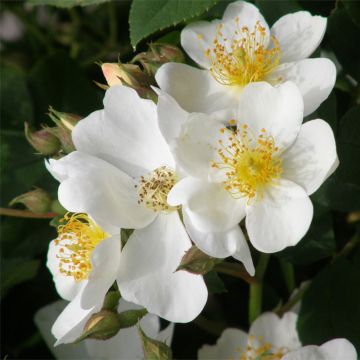

Rosier Tige David Austin Desdemona


Rosier Tige David Austin Desdemona
Rosa Desdemona - English Shrub Rose
Rosa Desdemona® 'Auskindling'
Rose
This item cannot be shipped to the selected country
Oversize package delivery charge from €6.90
Oversize package delivery charge from €6.90
Delivery to Corse prohibited
More information
Schedule delivery date,
and select date in basket
This plant carries a 24 months recovery warranty
More information
We guarantee the quality of our plants for a full growing cycle, and will replace at our expense any plant that fails to recover under normal climatic and planting conditions.
Oversize package: home delivery by special carrier from €6.90 per order..
Express home delivery from €8.90.
Oversize package: home delivery by special carrier from €6.90 per order..
Express home delivery from €8.90.
Delivery to Corse prohibited: UE law prohibits the import of this plant from mainland France to Corse as part of the fight against Xylella fastidiosa. Please accept our sincere apologies.
More information
Does this plant fit my garden?
Set up your Plantfit profile →
Description
The English Rose Desdemona is a delightful English novelty, whose flowers evoke porcelain roses, lightly shaded with peach pink at the beginning of flowering, opening slightly into pure white calyxes revealing barely visible pretty stamens. Their flowers have a the whirl of their incurved petals, and release a heavy fragrance of myrrh. Despite their delicate appearance, they do not suffer in a humid climate. It is a very healthy bush with a spacious and airy habit from early summer until the first frost. A marvel to adopt in a classic, poetic or romantic garden.
'Desdemona' is a musk English rose (hybrid of R. moschata) introduced by David Austin in 2015. It stands out, like other roses in this group, for the perfection of its round cupped flowers measuring 10 cm (4in) in diameter, gathered in loose corymbs and abundantly produced from May-June until the frost. This vigorous shrub has spacious and airy growth, gradually bending outward at its top, forming a bush with a flexible habit of 1.20m (4ft) in height and 1m (3ft) in width. It is a very healthy rose, resistant to diseases and of beautiful vigour. Its foliage is typical of musk roses: the odd-pinnate leaves have five to seven elliptical-ovate leaflets with dentate edges. Their colour is a bright green slightly tinged with purple, shiny on the upper side and cottony on the underside. Its stems are practically without thorns, they are quite resistant and do not require staking. The ovoid fruit is red and villous.
The English rose Desdemona was named in honour of the heroine of Othello, a tragedy by W. Shakespeare in which this innocent young girl falls victim to a plot that will cost her life. This rose embodies purity and encourages meditation, as if it brings the garden into a world of legends. It can be associated, like other English roses, with a bed of flowering shrubs, perennials or annuals with light flowering. It is of value in the garden and can integrate into a small hedge, reign over the lawn, or border the patio. Its roses last a long time, both on the bush and in a vase, in a soft colour that does not fade in the rain.
Obtained by David Austin in 2015.
Report an error about the product description
Rosa Desdemona - English Shrub Rose in pictures


Plant habit
Flowering
Foliage
Botanical data
Rosa
Desdemona® 'Auskindling'
Rosaceae
Rose
Cultivar or hybrid
Other David Austin Roses
Planting and care
Plant your English Desdemona Rose in a sunny or lightly shaded location. English roses are tolerant but won't like excessive limestone. They will adapt to any garden as long as the soil is well worked and rich enough. To plant your rose, work the soil by crumbling it and put an amendment at the bottom of the planting hole, such as bonemeal. Water generously after planting to eliminate air pockets. Water regularly for a few weeks to encourage rooting. Pruning English roses is essential for flowering. At the end of winter, shorten the branches to 3-5 buds above the ground (at the lowest), choose a bud pointing outward for a more elegant habit. Take advantage of this pruning to remove dead wood and unsightly branches. Pruning should be done at a slant above a bud. As the flowers bloom, remove faded flowers, as this stimulates the development of other buds.
Planting period
Intended location
Care
-
, onOrder confirmed
Reply from on Promesse de fleurs
Haven't found what you were looking for?
Hardiness is the lowest winter temperature a plant can endure without suffering serious damage or even dying. However, hardiness is affected by location (a sheltered area, such as a patio), protection (winter cover) and soil type (hardiness is improved by well-drained soil).

Photo Sharing Terms & Conditions
In order to encourage gardeners to interact and share their experiences, Promesse de fleurs offers various media enabling content to be uploaded onto its Site - in particular via the ‘Photo sharing’ module.
The User agrees to refrain from:
- Posting any content that is illegal, prejudicial, insulting, racist, inciteful to hatred, revisionist, contrary to public decency, that infringes on privacy or on the privacy rights of third parties, in particular the publicity rights of persons and goods, intellectual property rights, or the right to privacy.
- Submitting content on behalf of a third party;
- Impersonate the identity of a third party and/or publish any personal information about a third party;
In general, the User undertakes to refrain from any unethical behaviour.
All Content (in particular text, comments, files, images, photos, videos, creative works, etc.), which may be subject to property or intellectual property rights, image or other private rights, shall remain the property of the User, subject to the limited rights granted by the terms of the licence granted by Promesse de fleurs as stated below. Users are at liberty to publish or not to publish such Content on the Site, notably via the ‘Photo Sharing’ facility, and accept that this Content shall be made public and freely accessible, notably on the Internet.
Users further acknowledge, undertake to have ,and guarantee that they hold all necessary rights and permissions to publish such material on the Site, in particular with regard to the legislation in force pertaining to any privacy, property, intellectual property, image, or contractual rights, or rights of any other nature. By publishing such Content on the Site, Users acknowledge accepting full liability as publishers of the Content within the meaning of the law, and grant Promesse de fleurs, free of charge, an inclusive, worldwide licence for the said Content for the entire duration of its publication, including all reproduction, representation, up/downloading, displaying, performing, transmission, and storage rights.
Users also grant permission for their name to be linked to the Content and accept that this link may not always be made available.
By engaging in posting material, Users consent to their Content becoming automatically accessible on the Internet, in particular on other sites and/or blogs and/or web pages of the Promesse de fleurs site, including in particular social pages and the Promesse de fleurs catalogue.
Users may secure the removal of entrusted content free of charge by issuing a simple request via our contact form.
The flowering period indicated on our website applies to countries and regions located in USDA zone 8 (France, the United Kingdom, Ireland, the Netherlands, etc.)
It will vary according to where you live:
- In zones 9 to 10 (Italy, Spain, Greece, etc.), flowering will occur about 2 to 4 weeks earlier.
- In zones 6 to 7 (Germany, Poland, Slovenia, and lower mountainous regions), flowering will be delayed by 2 to 3 weeks.
- In zone 5 (Central Europe, Scandinavia), blooming will be delayed by 3 to 5 weeks.
In temperate climates, pruning of spring-flowering shrubs (forsythia, spireas, etc.) should be done just after flowering.
Pruning of summer-flowering shrubs (Indian Lilac, Perovskia, etc.) can be done in winter or spring.
In cold regions as well as with frost-sensitive plants, avoid pruning too early when severe frosts may still occur.
The planting period indicated on our website applies to countries and regions located in USDA zone 8 (France, United Kingdom, Ireland, Netherlands).
It will vary according to where you live:
- In Mediterranean zones (Marseille, Madrid, Milan, etc.), autumn and winter are the best planting periods.
- In continental zones (Strasbourg, Munich, Vienna, etc.), delay planting by 2 to 3 weeks in spring and bring it forward by 2 to 4 weeks in autumn.
- In mountainous regions (the Alps, Pyrenees, Carpathians, etc.), it is best to plant in late spring (May-June) or late summer (August-September).
The harvesting period indicated on our website applies to countries and regions in USDA zone 8 (France, England, Ireland, the Netherlands).
In colder areas (Scandinavia, Poland, Austria...) fruit and vegetable harvests are likely to be delayed by 3-4 weeks.
In warmer areas (Italy, Spain, Greece, etc.), harvesting will probably take place earlier, depending on weather conditions.
The sowing periods indicated on our website apply to countries and regions within USDA Zone 8 (France, UK, Ireland, Netherlands).
In colder areas (Scandinavia, Poland, Austria...), delay any outdoor sowing by 3-4 weeks, or sow under glass.
In warmer climes (Italy, Spain, Greece, etc.), bring outdoor sowing forward by a few weeks.












































